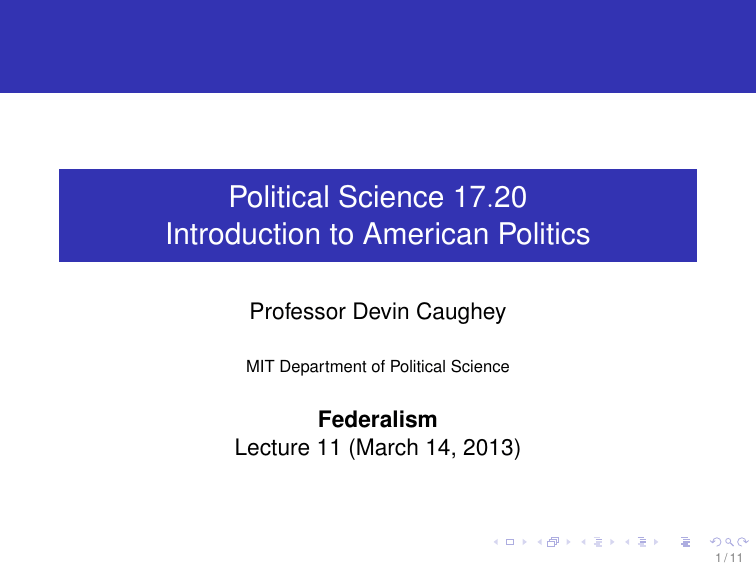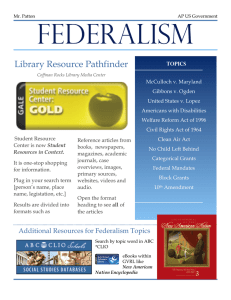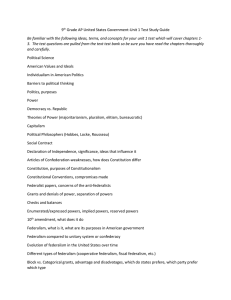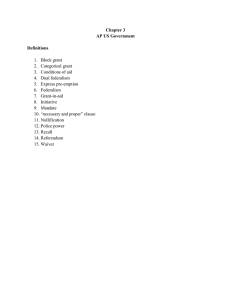Political Science 17.20 Introduction to American Politics Professor Devin Caughey
advertisement

Political Science 17.20 Introduction to American Politics Professor Devin Caughey MIT Department of Political Science Federalism Lecture 11 (March 14, 2013) 1 / 11 Outline 1 Origins, Justification, and Critiques 2 Federalism in Practice 2 / 11 Outline 1 Origins, Justification, and Critiques 2 Federalism in Practice 3 / 11 Origins of Federalism Federalism: division of authority between two or more levels of government (contrast with a confederation or unitary system) Federalism was a fait accomplis before the Constitution. Protection of state/local power necessary for Constitution to be adopted (Senate, enumerated powers, etc.) Centrality of slavery and its legacy Dual Federalism: National and subnational governments have clearly divided spheres of authority. Federalist 45: “The powers [of] the Federal Government are few and defined. Those [of] the State Governments are numerous and indefinite.” 4 / 11 Defenses of Federalism The states as laboratories of democracy (Louis Brandeis): a state may, if its citizens choose, serve as a laboratory; and try novel social and economic experiments without risk to the rest of the country. Competitive federalism (James Buchanan—not the president): Federalism as market of competing governments → Efficiency, Tiebout sorting States’ rights must be credible commitment. Threat of exit (secession) is crucial. Also requires national government to prevent barriers. (Note the influence of philosophical pragmatism.) 5 / 11 Critiques of Federalism Tyranny of local majorities Inability to tackle common problems Race to the bottom Negative externalities 6 / 11 Outline 1 Origins, Justification, and Critiques 2 Federalism in Practice 7 / 11 Evolution of Modern Federalism 17th Amendment (direct election of senators) Modern industrial society provoked national regulation Constitutional revolution of the New Deal Association with racism discredited states’ rights Expansion of federal tax base → control of money The New Federalism: conservative effort to roll back expansive interpretation of national power, esp. Commerce 8 / 11 Mechanisms of Federal Control Carrots (matching grants, etc.) Sticks (mandates, regulation) Cross-cutting requirements (e.g., anti-discrimination, anti-pollution) Crossover sanction (e.g., highway funds and drinking age) Dual federalism: authority shared (often contested → Kettl on disaster relief) federal programs implemented by states and localities (employment growth faster than federal gov’t) 9 / 11 Problems with Federalism Cutthroat competition: Trade deals under the Articles of Confederation Competition to attract businesses Race to the Bottom: Welfare payements Labor standards Environmental regulation The California Effect: Fuel efficiency standards 10 / 11 Policy Preferences vs. Constitutional Principles Medical marijuana: State legalization vs. national prohibition Gonzales v. Raich → Scalia concurrence Gay marriage: State marriage laws vs. national Defense of Marriage Act Windsor v. United States (pending before Supreme Court) 11 / 11 MIT OpenCourseWare http://ocw.mit.edu 17.20 Introduction to American Politics Spring 2013 For information about citing these materials or our Terms of Use, visit: http://ocw.mit.edu/terms .







